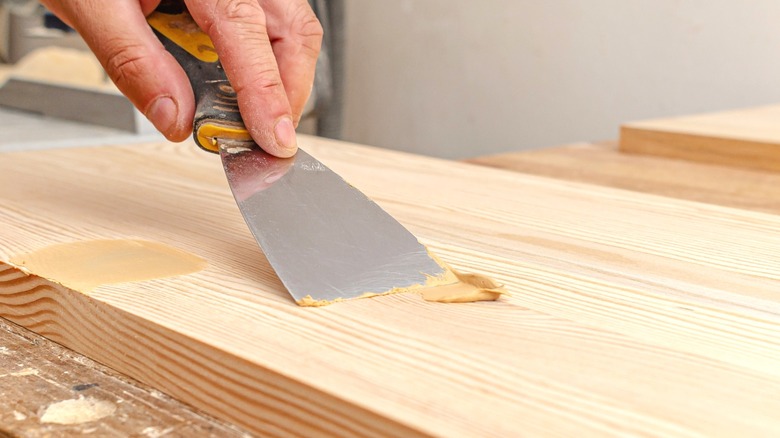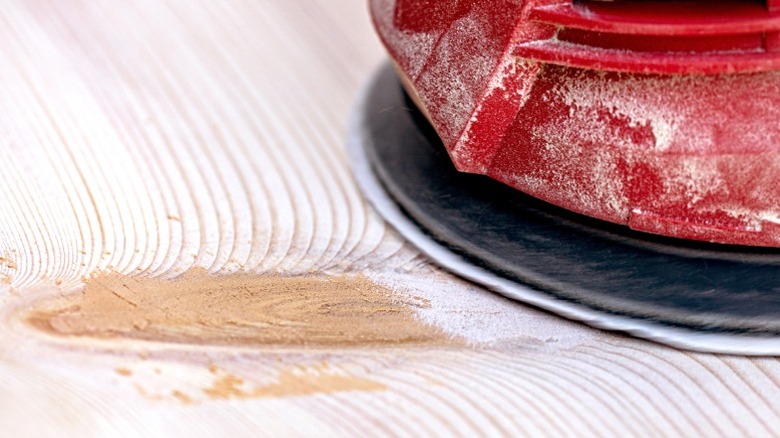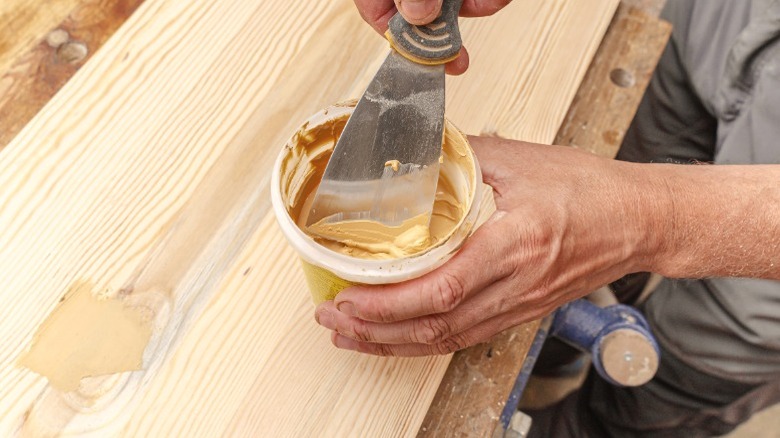When Completing DIY Repairs, Is Wood Filler Or Putty Better For The Job?
Wood-filling compounds are a boon to any woodworker, saving their hard work from the everyday dings, dents, cracks, and scratches that can drag down its final appearance. Adding a minor step to ensure a professional finish, these simple pastes are quick and effortless to apply. The hardest part, in some ways, comes when it's time to choose a product. While many DIYers (and even some pros) may consider wood filler and putty as interchangeable and equally capable of meeting their needs, the two products actually have distinct uses with surprisingly little overlap. Whether you're filling holes in outdoor siding or fixing gaps in old hardwood flooring, the final look and performance will hinge on you making the right choice.
Talking exclusively with HouseDigest, home remodeling expert Bob Beacham underscored just how tricky it can be to pick between wood filler and putty. "Despite the different names, both usually come as a kind of paste, either squeezed from a tube or scooped from a can," he explained. "There are hundreds of different products and what they're called can be confusing. It's really important to read the descriptions to see whether they are appropriate for a particular application." Generally, though, Beacham describes critical differences that define their purpose, offering valuable insights when starting the search for the best material for your project.
Expert tips into when to use wood filler or wood putty
As Beacham discussed, choosing between wood filler and putty depends on the wood's condition and context. "Wood filler is usually sawdust suspended in a hardener (maybe glue or varnish)," he said in his exclusive House Digest interview, noting it is primarily used indoors. "You can DIY wood filler with white glue and sawdust for a very close match to the wood you're working with. Mixing it can be a bit hit and miss, though, and perhaps not for your average DIYer."
Wood filler is ideal for concealing nail and screw holes, small gaps, and cracks in furniture, floors, countertops, and other interior applications. Unlike wood putty, filler is normally for unfinished wood, where it binds with wood fibers and hardens. "It's usually white or cream colored. It dries very hard and can then be sanded and stained or painted," Beacham said. Though exterior varieties exist, filler is generally unsuitable for outdoor wood, as it isn't flexible and can crack or shrink from humidity changes.
Wood putty, by contrast, won't crack or shrink and is typically waterproof, making it more practical for use outdoors. Nevertheless, it does have certain disadvantages, such as longer drying times and limited workability. Beacham explained, "Wood putty is usually oil-based with other ingredients like plastic, stain, or other ingredients to bulk it out. It's a synthetic product and has no wood content at all. It is usually used on wood that's already finished and comes in a bunch of colors because most cannot be stained or painted."
Pro tips for effectively using wood filler and putty
Despite the differences in where you use them, the proper use of wood filler and wood putty can look similar. You must prep the surface, ensuring it's clean and debris-free, and apply the filler or putty while soft so it can firm up while in place. "Some products come with a plastic spreader for application, or you can use a painter's trowel or putty knife," Beacham said, recommending you work the paste well into the hole. "With filler you can overfill a little and sand flat. With putty you need to make it nice and smooth."
Wood putty can be trickier to use but takes fewer steps than filler. Beacham explained that, while filler has to dry before you can sand or paint it, you only need to spread and smooth wood putty to complete the job. "You can also get putty in sticks, like a fat crayon. These can be good for repairing surface scratches in furniture," he added. In terms of the holes they can fill, Beacham pointed out their limitations. "Neither can fill particularly large holes (say 1/2 inch max). For those, try two-part epoxy filler," he stated, noting this is sometimes called putty. "Some can be sanded and painted (though might need a primer), and used indoors and out. So why wouldn't you use it for everything? First, it's often comparatively expensive. Second, like any two-part epoxy, it's tricky to apply, and you have to work fast."


